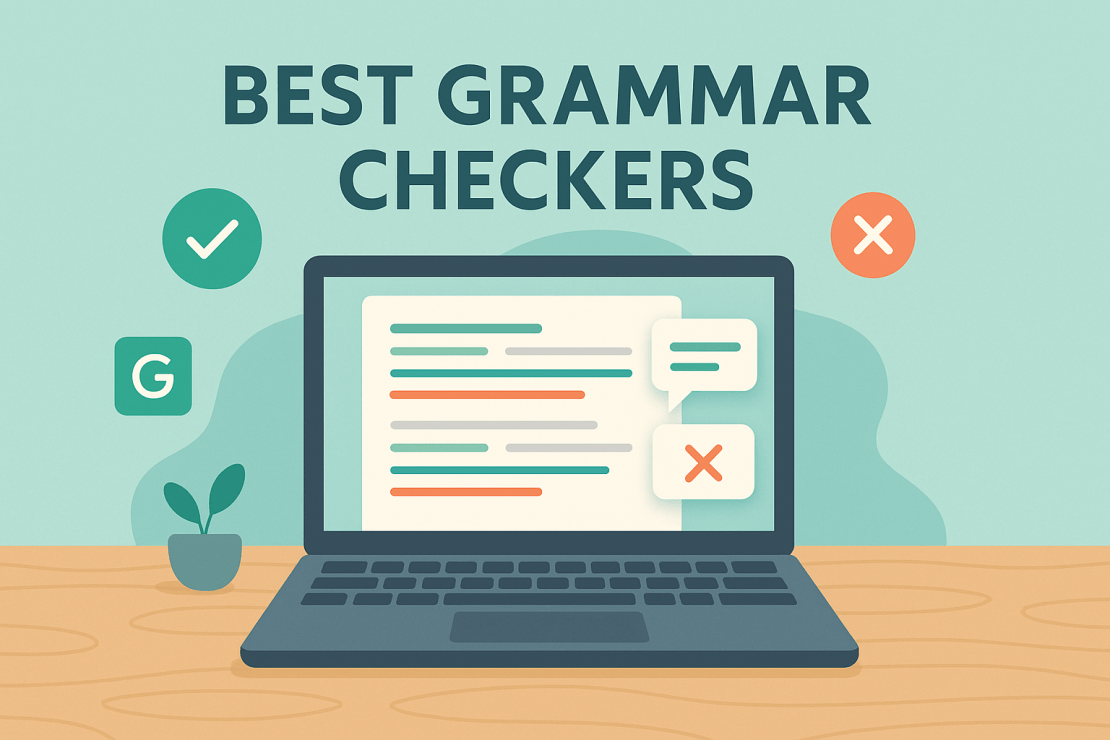Writing an academic paper, polishing a blog post, or simply trying to avoid embarrassing email typos all require a reliable grammar checker that can save you time — and sometimes your reputation. But not all tools are built the same. Some are bare-bones spell checkers, while others go deep into sentence structure, tone, clarity, and even AI-powered rewriting.
We tested and reviewed the most popular grammar checkers, free and paid, to see how they actually perform in real-world writing. Each tool was scored based on accuracy, usability, features, and value for money. Some impressed us with their depth and polish. Others… not so much.
If you’re a student, a professional writer, or just someone who wants cleaner writing with less effort, this guide will help you find the grammar checker that fits your style, needs, and budget.
Best Free Grammar Checkers
QuillBot / Scribb
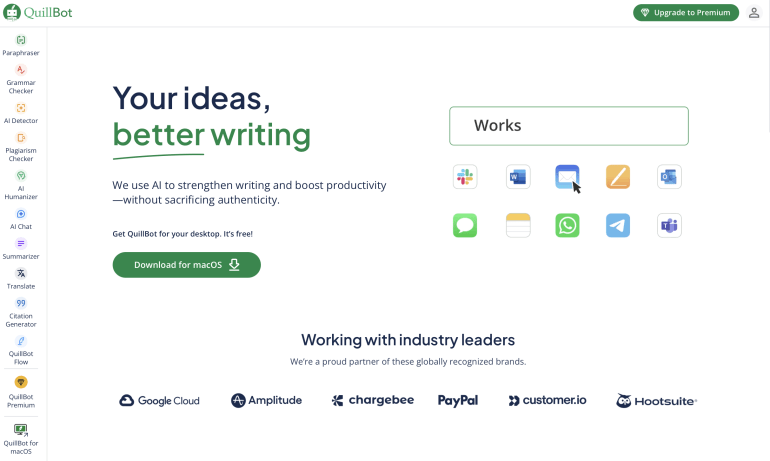 Best for: Students, professionals, and anyone who needs a fast, highly accurate grammar fix.
Best for: Students, professionals, and anyone who needs a fast, highly accurate grammar fix.
QuillBot (and Scribbr’s version of it, which runs on the same engine) was by far the best-performing tool in our test. It caught all 20 errors in the sample text — spelling, punctuation, phrasing, grammar, you name it — and fixed every one of them without making things worse. No other free tool came close to that level of accuracy.
You can paste your text in and start editing right away. No need to sign up, no character limits to hit, and no confusing dashboards. There’s even a one-click “Fix All Errors” button if you just want to clean everything up fast, or you can go line by line if you prefer more control. The browser extension is a nice bonus, and formatting/export tools are built in, so you don’t need to copy and paste into a separate editor.
QuillBot and Scribbr offer the same results, and both are 100% free to use. If you’re trying to polish up academic writing, job applications, or even just a blog post, this is the most complete and headache-free checker we tested.
Pros:
- Catches and fixes 100% of issues in one pass.
- No sign-up or limits; works instantly.
- “Fix All Errors” option saves time.
- Clean interface with extras like export and formatting.
Cons:
- Honestly, none.
If you just want something that works without nagging you to upgrade or asking for your email, QuillBot is the no-brainer pick.
LanguageTool
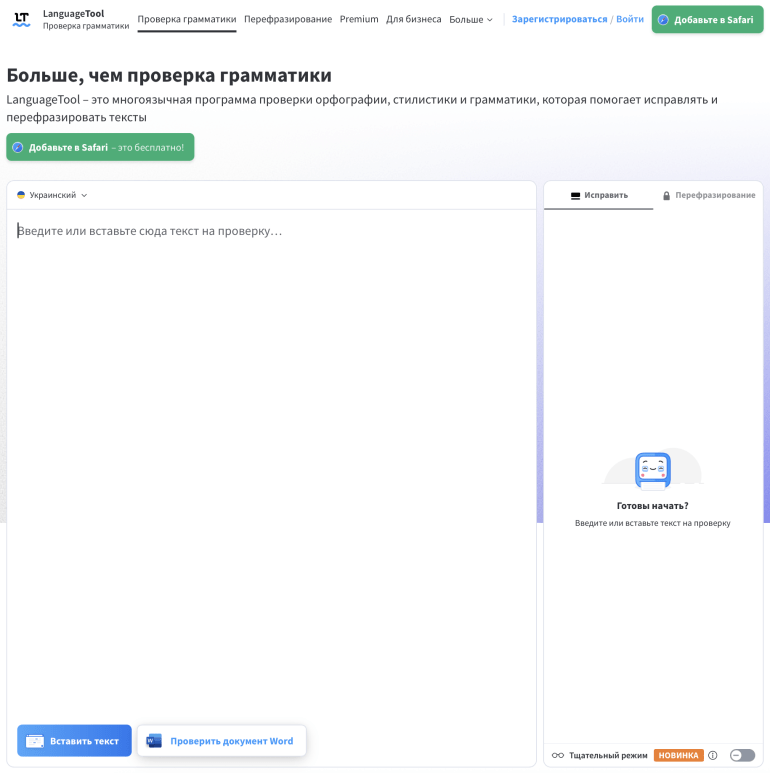 Best for: Multilingual users and writers who want detailed grammar feedback without needing to sign up.
Best for: Multilingual users and writers who want detailed grammar feedback without needing to sign up.
LanguageTool came in just behind QuillBot in our testing, correcting 19 out of 20 errors with impressive consistency. It accurately flagged spelling mistakes, punctuation issues, and word choice problems, making it one of the most precise tools out there, especially considering it’s completely free to use.
One of its standout strengths is support for multiple languages. The interface is clean and doesn’t require any sign-up, so you can start editing right away. That said, fixing each error takes two clicks (select the suggestion, then apply it), and there’s no “Fix All” option, which slows things down if you’re working with longer texts.
Another nice touch: if your sentence could be interpreted a few different ways, LanguageTool often gives you multiple options instead of just one default suggestion. This is something most tools don’t bother with.
Pros:
- High accuracy (missed just one error);
- No sign-up required;
- Works in multiple languages;
- Offers nuanced suggestions;
- Clean interface with browser extension.
Cons:
- No “Fix All Errors” button;
- Two clicks to correct each issue.
If you’re writing in more than one language or just want a reliable, ad-free checker that respects your workflow, LanguageTool is one of the best you’ll find, even among some paid options.
Grammarly
 Best for: Everyday writing like emails, blog posts, and messages, as long as you don’t mind signing up first.
Best for: Everyday writing like emails, blog posts, and messages, as long as you don’t mind signing up first.
Grammarly is easily the most recognizable name on this list and for good reason. Its interface is sleek, the browser extension is well-built, and it gives solid suggestions when it works. However, here’s the catch: a significant portion of its value is locked behind a premium paywall.
In our test, the free version of Grammarly caught 11 out of 20 errors, about the same as mid-tier tools like GrammarCheck. It flagged more potential issues in the text, but you’d need to pay to see or fix them.
Usability is a mixed bag. You’ll need to create an account before you can use it, and fixing errors takes two clicks. Suggestions are grouped by type (e.g., grammar, clarity, tone), but you can’t view or apply them all at once. It’s a clean, intuitive system, just not the fastest or most generous if you’re on the free plan.
Pros:
- Polished interface and browser extension;
- Multiple suggestions when there’s ambiguity;
- Decent free coverage for everyday writing.
Cons:
- Requires sign-up;
- No “Fix All” button;
- The free version only catches basic errors;
- Premium needed for full access;
- Slower editing flow.
If you already use Grammarly for spelling and tone, the grammar checker is a nice bonus. But if you’re looking for full coverage without paying, there are stronger options on this list.
Best for: Quick fixes when you want a no-login grammar tool and don’t mind a dated interface.
GrammarCheck
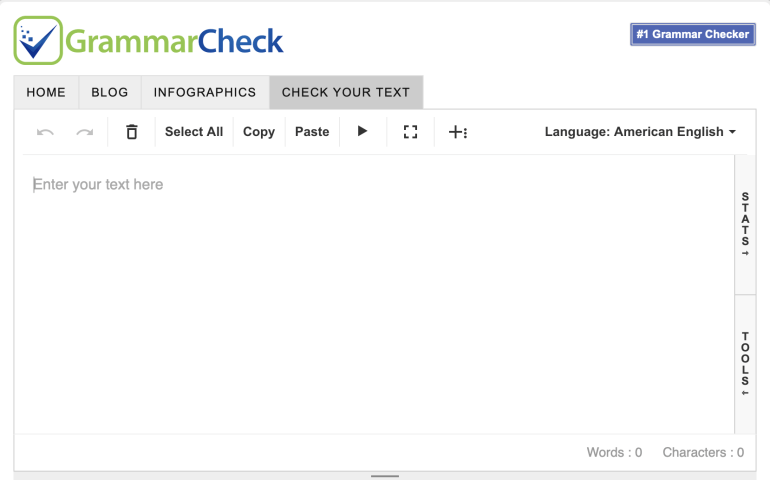 GrammarCheck isn’t trying to reinvent anything, and that’s kind of the point. It’s a simple copy-paste checker that caught 11 out of 20 errors in our test, putting it roughly on par with the free version of Grammarly. It didn’t introduce any new problems either, which gives it an edge over some flashier tools.
GrammarCheck isn’t trying to reinvent anything, and that’s kind of the point. It’s a simple copy-paste checker that caught 11 out of 20 errors in our test, putting it roughly on par with the free version of Grammarly. It didn’t introduce any new problems either, which gives it an edge over some flashier tools.
There’s no sign-up, no ads getting in your way, and you can accept suggestions with a single click. For basic grammar issues like typos and missing commas, it does the job. But don’t expect it to spot trickier problems with sentence structure or tone. Those often go unnoticed.
The interface definitely feels a bit outdated, and there’s no “Fix All” button to apply everything in one go. Also worth noting: clicking the “Deep Check” button just takes you to Grammarly’s website, which makes things feel a little clunky and inconsistent.
Pros:
- No sign-up required;
- Simple to use; just paste and go;
- One-click corrections;
- Doesn’t introduce new errors.
Cons:
- Misses deeper issues like awkward phrasing or structure;
- No “Fix All” button;
- Old-school interface;
- “Deep Check” redirects to Grammarly.
If you just want something lightweight to catch basic mistakes and move on, GrammarCheck is fine. It won’t impress you, but it won’t waste your time either.
SpinBot
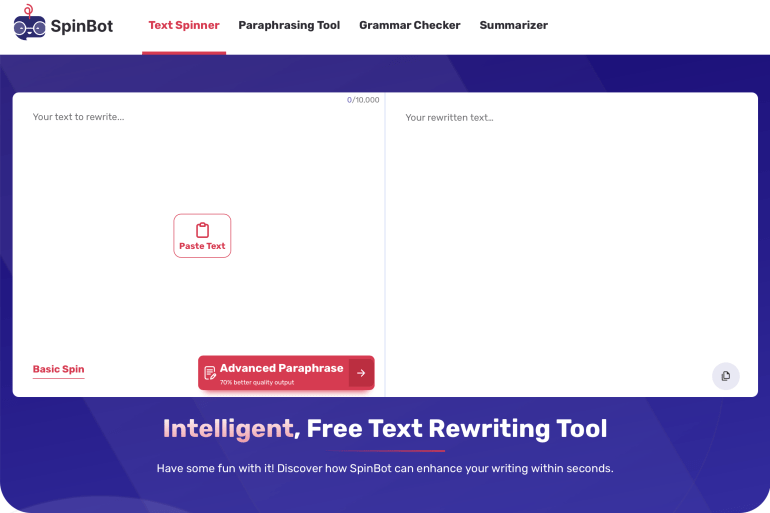 Best for: Quick, no-frills grammar cleanups when you want results fast and don’t need much explanation.
Best for: Quick, no-frills grammar cleanups when you want results fast and don’t need much explanation.
SpinBot surprised us in a good way. It found all 20 errors in our test text and corrected 17 of them. The remaining three were flagged but left without suggestions, which was a bit of a letdown. Still, that kind of detection rate puts it ahead of most other free tools.
There’s no account required and no clutter. Just paste in your text, hit “Fix All Errors,” and you’re done. It’s simple, fast, and accurate enough for casual writing. That said, you don’t get any explanations about what went wrong or why a suggestion was made. And if you’d prefer to fix errors one at a time or skip a correction, you’re out of luck. It’s all or nothing.
SpinBot feels like a tool built for speed, not control. If that’s what you need, it works. But for more nuanced editing, you’ll probably want a bit more flexibility.
Pros:
- Catches every issue;
- Fixes most of them accurately;
- One-click “Fix All” feature;
- No sign-up, no distractions.
Cons:
- No error explanations;
- Can’t reject individual suggestions;
- Leaves a few errors flagged with no fix.
If you’re okay with a fast, automated sweep and don’t care about the “why,” SpinBot’s a great tool to keep bookmarked.
Best Paid Grammar Checkers
Grammarly Premium
 Best for: Writers who want a full-suite writing assistant. Not just grammar help, but tone, clarity, vocabulary, AI writing, and even plagiarism checking.
Best for: Writers who want a full-suite writing assistant. Not just grammar help, but tone, clarity, vocabulary, AI writing, and even plagiarism checking.
Grammarly shows up in just about every conversation around writing tools. Besides its grammar checking features, it’s a full writing assistant. Whether you’re editing in your browser, typing on your phone, or working in Word, Grammarly Premium brings everything together: grammar, tone, clarity, and even originality. In our testing, it lived up to the hype and delivered the kind of polish you’d expect from a top-tier paid tool.
It caught all the intentional mistakes we planted in a draft, offered clear explanations, and went beyond surface-level fixes with advanced suggestions for engagement, word variety, and sentence flow. The interface is slick, fast, and intuitive, and you can work through alerts quickly; most issues can be corrected with a single click. Setting writing goals lets Grammarly tailor its feedback to fit your project.
And then there’s GrammarlyGo, the built-in generative AI assistant. You can use prompts like “rephrase this paragraph” or “write a 3-line summary,” and it delivers polished suggestions instantly.
Grammarly also includes a plagiarism checker that compares your text against billions of web pages, plus deep readability metrics, formatting tools, and mobile access through the Grammarly Keyboard app.
Pricing:
- $30/month (monthly plan);
- $20/month (quarterly);
- $12/month (annual plan).
Pros:
- One of the most complete writing tools on the market.
- Fixes grammar, clarity, tone, and vocabulary in real time.
- Includes plagiarism checker and AI writing assistant.
- Works across web, desktop, mobile.
- Writing suggestions are fast, accurate, and personalized.
Cons:
- The monthly plan is pricey,
- The plagiarism checker isn’t as strong as Turnitin/Scribbr,
- Google Docs integration still needs improvement.
If you’re a student, content creator, or professional who writes daily, Grammarly Premium makes life easier.
QuillBot Premium
 Best for: Writers who want more than just grammar help, including paraphrasing, citations, AI assistance, and multilingual support.
Best for: Writers who want more than just grammar help, including paraphrasing, citations, AI assistance, and multilingual support.
QuillBot might be best known for its paraphrasing tool, but the Premium version is much more than that. Alongside its standout grammar checker, it offers a plagiarism detector, built-in translator, citation generator, summarizer, and even an AI content assistant all in one tidy interface.
In testing, the grammar checker was sharp. It flagged every mistake we threw at it — spelling, grammar, tone, sentence flow — and offered clear suggestions for how to improve readability. It even nudged us toward more active voice and better engagement, which most grammar tools skip. The interface is clean, and the browser extension makes it easy to use QuillBot across platforms like Google Docs, Gmail, and LinkedIn.
One unique strength: QuillBot supports multiple languages and regional English variations (like US, UK, AU, and CA), which is a big plus for international users. Just note that the grammar checker can be a little aggressive out of the box. Some users might find themselves overwhelmed with suggestions, especially in technical or structured text.
Pricing:
- $30/month (monthly);
- $20/month (quarterly);
- $12/month (annually).
If you’re writing every day or working on complex content, the premium plan is worth it, and you can save up to 59% with annual billing.
Pros:
- All-in-one toolkit: grammar, paraphrasing, citations, translation, and AI.
- Top-tier grammar accuracy and fluency feedback.
- Supports multiple languages and English dialects.
- Strong plagiarism checker and citation tools.
- Chrome extension for writing across the web.
Cons:
- Can be overly strict with minor formatting quirks.
- The monthly price is high without a long-term discount.
- The free plan is too limited for heavy users.
If you’re looking for a grammar tool that doubles as a smart writing assistant, QuillBot Premium might be the best value on the list, especially if you’re juggling academic writing, multilingual content, or just want AI at your fingertips.
Linguix Premium
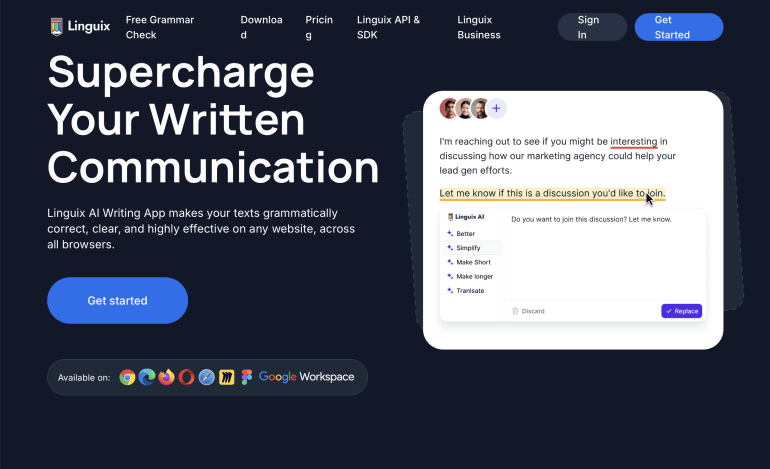 Best for: Bloggers, marketers, and small teams who want a grammar checker that doubles as a lightweight content assistant.
Best for: Bloggers, marketers, and small teams who want a grammar checker that doubles as a lightweight content assistant.
Linguix might not have the name recognition of Grammarly or QuillBot, but it’s a surprisingly capable tool with a growing fan base, and it does more than just fix grammar. Alongside its clean, distraction-free editor, you get features like AI-assisted writing, paraphrasing, team collaboration tools, and a mobile keyboard app for writing on the go.
When you paste your text into the Linguix editor, it instantly gives you a readability score and highlights any grammar, spelling, or style issues. Fixes are applied with a single click, and there’s even a built-in AI writer you can use to generate drafts or rewrite content in different tones.
What makes Linguix stand out is its style guide feature. If you’re managing a content team or publishing across platforms, you can define custom rules to keep your writing consistent — things like brand voice, tone preferences, or how to format product names. There are also typing shortcuts, which let you insert frequently used phrases (think email intros or social post templates) with a keystroke.
Pricing is also a strong point. The annual plan is just $70 for individual users, and team plans are competitively priced at $10/month per user (or less if billed annually). That’s a lot of value if you’re building content regularly and need more than basic grammar fixes.
Pros:
- Great value with strong team and workflow features;
- Built-in AI assistant and paraphrasing;
- Mobile keyboard app for writing on the go;
- Typing shortcuts save tons of time;
- Custom style guides help with consistency.
Cons:
- No plagiarism checker (unlike Grammarly and QuillBot);
- Doesn’t show a list of all issues; you have to scroll to find them;
- Limited ability to fine-tune feedback for specific writing goals or formats.
If you’re a solo blogger or part of a small writing team, Linguix offers a smart blend of grammar support, writing tools, and productivity features without breaking your budget. It’s not perfect, but it punches above its weight in all the right places.
ProWritingAid
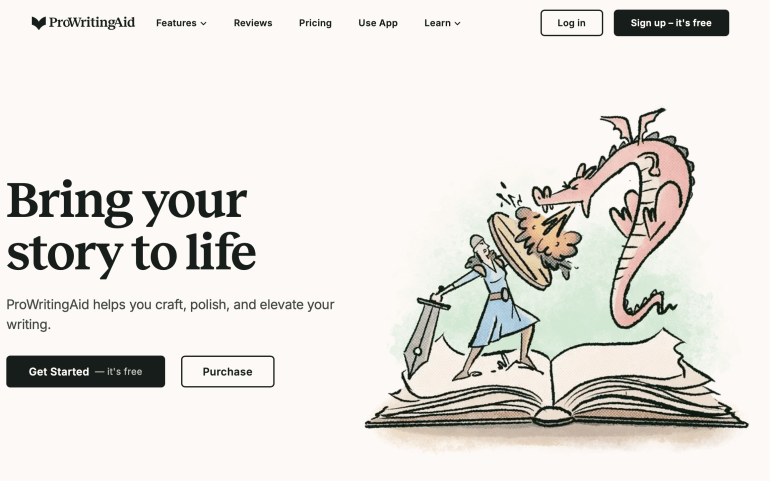 Best for: Authors, long-form writers, and anyone who wants deep writing insights.
Best for: Authors, long-form writers, and anyone who wants deep writing insights.
ProWritingAid feels more like a full-on editorial coach than a basic grammar checker. It’s packed with features like sentence structure tools, pacing analysis, vocabulary suggestions, style consistency checks, and even a plagiarism checker (though that costs extra). If you’re a novelist, technical writer, or someone who writes in bulk, it’s one of the most detail-oriented tools on the market.
The layout looks a lot like a traditional word processor, so it’s easy to find your way around. As you type or paste text into the editor, issues are underlined and color-coded in real time. You can also hit the “Realtime” button to view everything in one clean list, which is a lifesaver for longer drafts.
Where ProWritingAid really shines is in its deeper feedback. It tells you when you’re overusing certain phrases, when your pacing feels slow, and how your readability stacks up. There are tools for sentence variation, sticky wording, cliché detection, and more. If you’re someone who enjoys digging into your writing mechanics, it’s a goldmine.
That said, it’s not the most beginner-friendly experience. The dashboard has so many tabs, reports, and metrics that it can feel overwhelming at first. Also, you’ll need to buy a premium license to remove the 500-word limit on the free plan, and the plagiarism checker costs extra, even for premium subscribers.
Pricing:
- Premium: $30/month or $399 one-time;
- Premium Pro: $36/month or $699 one-time (Save 20% with promo codes if available).
Pros:
- Extremely thorough editing tools;
- Offers unique features like pacing and consistency checks;
- Great for long-form writing and publishing workflows;
- Repeats, readability, and sentence structure tools help improve style;
- Lifetime license available.
Cons:
- The 500-word limit on the free plan makes it hard to test;
- No built-in plagiarism checking unless you buy credits;
- The interface can feel overwhelming at first;
- Some users report lag with very long documents.
If you’re looking for a grammar checker that also teaches you how to become a better writer, ProWritingAid is worth the learning curve.
Conclusion: Which Grammar Checker Should You Use?
If you’re looking for the most accurate free tool with no strings attached, QuillBot (and Scribbr, which uses the same engine) is the clear winner. It fixed everything we threw at it and didn’t ask for an account. LanguageTool is a strong second, especially if you need grammar support in multiple languages.
On the paid side, Grammarly Premium offers the most polished user experience and is perfect for everyday writing across platforms. If you’re more of a long-form writer or want deeper feedback, ProWritingAid gives you a full editorial toolbox, but it takes more time to master. Meanwhile, Linguix is a smart middle-ground option for bloggers and teams who want helpful writing features without overpaying.
Every tool has its trade-offs. Some are fast and simple, others are packed with features but take more effort to learn. The key is choosing one that fits your writing habits and goals.
At the end of the day, grammar checkers should make your writing stronger, not get in your way. Use them as smart assistants, not crutches, and your writing will only get better from here.
